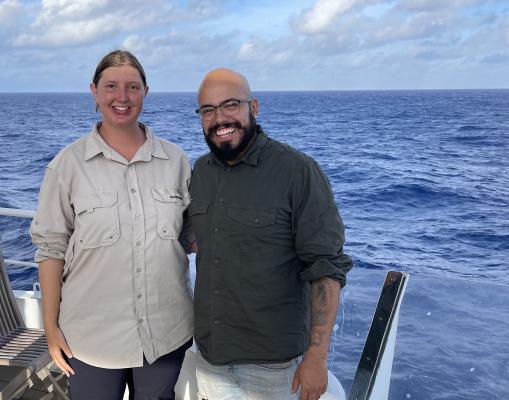USC Animal Ecology student Bianca Keys of Caloundra has completed a voyage of a lifetime, helping to map the abundance and distribution of seabirds in the North Tasman and South Coral seas.
In a month-long expedition aboard Schmidt Ocean Institute’s research vessel Falkor, Bianca led a team of student observers in identifying more than 3,300 seabirds.
The final-year student, who overcame seasickness and rough seas to work as a volunteer scientist with BirdLife Australia on the ‘Seafloor to Seabirds’ voyage, said it was a brilliant experience.
“Ever since I started to have a passion for seabirds, I have wanted to observe them in their natural habitat,” said Bianca, who left her job as a mortgage broking assistant to enrol at USC to follow her passion in animal conservation,“ she said.
“An expedition at sea was the perfect way to achieve this as it offered an incredible first-hand opportunity to gain valuable skills in seabird identification and behaviour.”
The four-week voyage was not without its challenges.
“While I have experience in terrestrial bird surveys, it is very different to identify seabirds when dealing with the lively and everchanging nature of the sea,” Bianca said.
“I had to cope with the rolling of the ship, the harsh sun and wind conditions and even seasickness, especially when sailing for the first time.”
Once the vessel left the Port of Brisbane on 6 February, Bianca and her colleagues worked from sunrise to sunset surveying seabirds and monitoring the water for debris and marine mammals.
Each observation was logged, and details were recorded about the species, total count, behaviours, and other observations that may provide a better understanding of seabirds, their relationships with other features of the ocean and the impact of humans on marine environments.
“One of the highlights from this experience was learning the many different species of marine birds – some of these would never be encountered unless you are on a sea voyage, a remote coral reef or an island,” Bianca said.
Under the guidance of onshore Principal Investigator Dr Eric Woehler from the University of Tasmania, Bianca trained and supervised other student observers, including USC PhD student and sessional academic Francisco Gelves-Gomez, who is from Colombia.
Francisco also assisted with other key aims of the expedition, which involved mapping underwater landscapes in the Coral Sea, collecting marine magnetic data and filtering seawater to investigate microplastic contamination.
The data collected will contribute to the Nippon Foundation-GEBCO global initiative to map the world’s seafloor by 2030.
Since arriving back on land, Bianca has returned to classes at USC’s Sunshine Coast campus and to her role as a research assistant on the “Valuing the Sunshine Coast’s Natural Assets” project, a collaboration between USC and Sunshine Coast Council.
Once she completes her degree at the end of this semester, Bianca plans to begin honours at Tasmania’s Institute for Marine and Antarctic Studies as a stepping stone into a PhD in marine science and ornithology.








